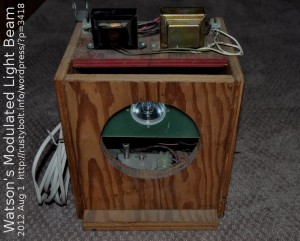A long time ago, about 1966, I wanted to modulate a light beam with audio. The LEDs available at that time were indicator grade, not bright enough to go any distance. So I decided I would build a modulator and connect it to a powerful incandescent light. At first I used a burned out car headlamp with the glass cut out of the front and a 12V tail light lamp mounted at the focal point. Later I removed the big reflector and installed the 12V, 20W halogen reflector light that is seen in the picture.
The AC from the transformers on the top was rectified and filtered, and the 18 or so volts DC supplied the modulator, a power transistor. The light was connected as the power transistor’s collector load resistor. The audio fed the power transistor and amplitude modulated the light.
The receiver originally was a solar cell connected to an amplifier, but I found that the phototransistors I got from Radio Shack were good receivers. But the main problem with modulating a light bulb is that the bandwidth is very low because the filament has to heat and cool as it responds to the audio. The received audio sounds very muffled and it’s difficult to understand. But the high power light will transmit a much greater distance than the dim indicator grade LEDs at that time.
Today I could remove the Halogen bulb and replace it with a 1 watt, 3 watt, or 5 watt red LED and it could be modulated with frequencies much higher than audio, so I could use a carrier and frequency modulate the beam, making it much harder for snoopers to demodulate. I could also use a laser beam and get very narrow beam that would be difficult to intercept, but the atmosphere could have enough disturbance to interrupt the beam over a longer distance. A LED with a lens or reflector can give a much narrower and more powerful beam without the problem that the laser has.
Later I built a pair of full duplex transmitter/receivers using PLL chips to frequency modulate the beam, and I used 5 mm LEDs for the transmitters. I mounted them in a 4 inch plastic drain pipe with a glass lens at the front. They worked fairly well, but I got really tired really fast setting up one of the units a thousand feet away, then coming back to adjust the beam focus and direction, then going down to the far end to do the same thing, then.. etc., etc. Whew! I spent most of my time traveling!












